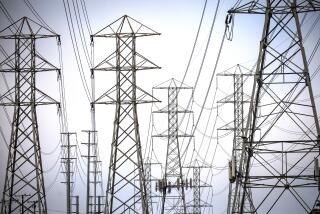Simple Steps Can Cut Your Thirst for Juice
- Share via
As my electricity bill begins to rival my mortgage payment, I’m paying closer attention to how much electricity my computers use. No, the Mac isn’t the reason parts of California are going dark now and then, but there’s no denying that personal computers contribute to the state’s thirst for power.
Just how much juice does an Apple need? It depends on the model. The iMac is the greenest of Apple’s desktop line, using about 150 watts of power--about the same as a typical 25-inch TV set. A Power Mac G4 Cube uses as many as 225 watts, and the tower-style Power Mac G3 or G4 can use as many as 330 watts, not including a monitor.
As for monitors, Apple’s 17-inch monitor uses about 115 watts, while the sleek flat-panel Studio Display uses only 50 watts. There’s the excuse you’ve been looking for to justify the extra cost of a flat-panel display.
One way to use less power is obvious: turn the Mac off when you aren’t using it. But booting up from a cold start takes a minute or more, and frequent cold starts take their toll on hard drive mechanisms. If you anticipate using the computer again soon, put the Mac to sleep instead: choose Sleep from the Finder’s Special menu and the Mac goes into a hibernation mode that uses less than 35 watts. Press a key and the computer wakes and is ready for action within seconds.
The Mac OS enables you to automate your energy diet. Using the Energy Saver control panel, you can have the Mac automatically power down its display, go to sleep or even shut down entirely after a period of inactivity. For fine control, click the control panel’s Show Details button; this reveals options for specifying separate sleep intervals for your system’s display and hard drive. Consider having the display go to dark after 30 minutes of disuse and having the entire system go to sleep after an hour.
A sleeping Mac is unable to check for incoming e-mail or perform other tasks. That’s a big drawback if you have a continuous Internet connection, such as a cable modem or DSL line, and you’ve set up your e-mail program to check for mail every few minutes. A compromise solution is to turn off the monitor when you won’t be using the computer for more than a half-hour or so. You lose the energy-saving benefits of sleep mode, but you still save some power, and you won’t delay the arrival of incoming e-mail.
The Energy Saver control panel also lets you set up a schedule for automatic shutdown and start-up. For example, businesses and schools can set up their Macs to shut down at night and start up in the morning.
For more power control, check out St. Clair Software’s Sleeper (https://www.stclairsoftware.com). This $25 shareware control panel provides more power-saving options than does the Mac OS Energy Saver. For example, Sleeper can spin down external hard drives; Energy Saver can’t.
And what if a blackout hits? The best weapon against power problems of all kinds is an uninterruptible power supply, or UPS. Plug a UPS into the wall and then plug the Mac into the UPS. When the power goes--or even glitches momentarily--the UPS kicks in, producing current from built-in rechargeable batteries.
A UPS generally will provide 10 to 20 minutes of emergency computing power--more than enough to save your work and shut down safely. A UPS also is a surge suppressor, providing protection from lightning strikes and from the power surges that can occur when power is restored after an outage.
American Power Conversion (https://www.apc.com) and Belkin (https://www.belkin.com) are two leading UPS manufacturers. Both companies’ Web sites are useful resources; specify what kind of computer and peripherals you have and the sites recommend an appropriately sized UPS. A light-duty UPS suitable for an iMac costs less than $100; a UPS capable of running a G4 and a 17-inch monitor costs about $250.
That isn’t cheap, but it’s worthwhile insurance against lost work and hardware damage.
*
Jim Heid is a contributing editor for Macworld magazine




